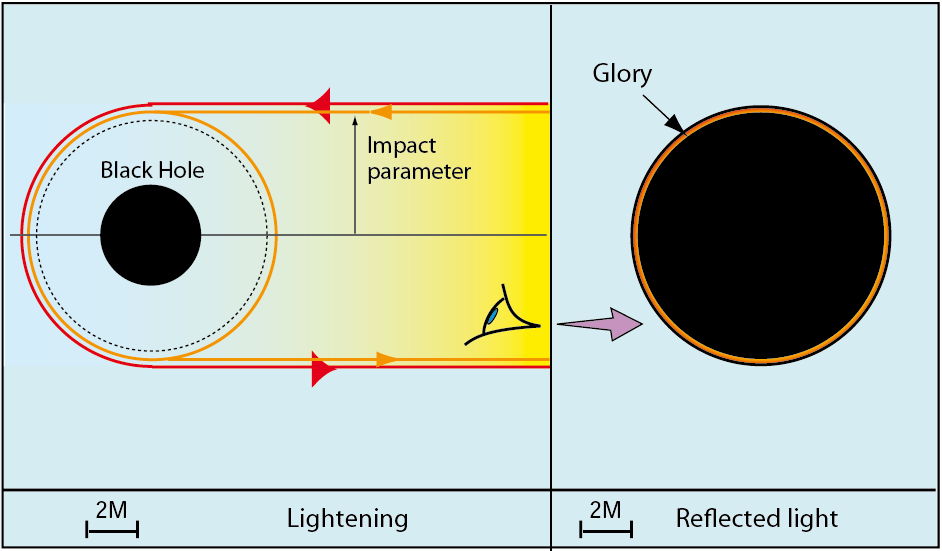Antony Rawlinson wrote: ↑Mon Apr 12, 2021 8:09 am
Chris Peterson wrote: ↑Sun Apr 11, 2021 1:08 pm
Antony Rawlinson wrote: ↑Sun Apr 11, 2021 8:18 am
The text says it's computer-generated. Can anyone say what real-life scale it represents, in terms of distance/size, mass and time?
I believe this is a simulation of stellar mass black holes colliding. So the black holes are several solar masses, and their event horizons several tens of kilometers across.
Thanks for this and the clarification, but can you or someone else say what the timescale of the animation is? Is it meant to be real-time?
I've looked far and wide, but I can't find a specific answer to that. I'm sure it depends on the masses of the two black holes, and perhaps also their spins. All I know is that it starts slowly and the last stages are sub-second. There are vague hints at
https://en.wikipedia.org/wiki/Binary_black_hole :
Lifecycle
Inspiral
The first stage of the life of a binary black hole is the inspiral, a gradually shrinking orbit. The first stages of the inspiral take a very long time, as the gravitation waves emitted are very weak when the black holes are distant from each other. In addition to the orbit shrinking due to the emission of gravitational waves, extra angular momentum may be lost due to interactions with other matter present, such as other stars.
As the black holes’ orbit shrinks, the speed increases, and gravitational wave emission increases. When the black holes are close the gravitational waves cause the orbit to shrink rapidly.
The last stable orbit or innermost stable circular orbit (ISCO) is the innermost complete orbit before the transition from inspiral to merger.
Merger
This is followed by a plunging orbit in which the two black holes meet, followed by the merger. Gravitational wave emission peaks at this time.
Ringdown
Immediately following the merger, the now single black hole will “ring”. This ringing is damped in the next stage, called the ringdown, by the emission of gravitational waves. The ringdown phase starts when the black holes approach each other within the photon sphere. In this region most of the emitted gravitational waves go towards the event horizon, and the amplitude of those escaping reduces. Remotely detected gravitational waves have a fast reducing oscillation, as echos of the merger event result from tighter and tighter spirals around the resulting black hole.
...
Observation
The first observation of stellar mass binary black holes merging, GW150914, was performed by the LIGO detector.[15][22][23] As observed from Earth, a pair of black holes with estimated masses around 36 and 29 times that of the Sun spun into each other and merged to form a 62 solar mass black hole (approximate) on 14 September 2015, at 09:50 UTC.[24] Three solar masses were converted to gravitational radiation in the final fraction of a second, with a peak power 3.6×1056 ergs/second (200 solar masses per second),[15] which is 50 times the total output power of all the stars in the observable universe.[25] The merger took place 440+160
−180 megaparsecs from Earth,[26] between 600 million and 1.8 billion years ago.[22] The observed signal is consistent with the predictions of numerical relativity.[2][3][4]
I suspect the final few orbits take milliseconds, so this video is very likely extremely slowed down! There's probably a more specific answer here -
https://www.black-holes.org/explore/movies - but I haven't found it yet. There are some possible answers at Quora, but take them with a grain of salt.
EDIT: I see neufer posted while I was typing mine up, though I'm not sure if he was trying to answer the timeline question or not. But perhaps his implication is that because relativistic time dilation effects are extreme during the merger, a timeline is meaningless? But surely, for those outside the immediate vicinity, there would be some valid time taken for stellar mass blackholes to appear to merge over the last, oh, 100 km of separation?
 When Black Holes Collide
When Black Holes Collide

